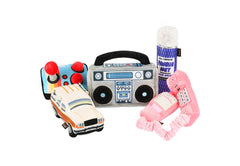The following is a repost from Tails From the Lab - a blog written by our friends over at Photo Lab Pet Photography. This is the fourth out of five posts from their "Learning to Speak Dog" series.
Part One can be read here: Learning to Speak Dog Part One
Part Two can be read here: Learning to Speak Dog Part Two
Part Three can be read here: Learning to Speak Dog Part Three
The topic of whether dogs have feelings has been a hot one for years. To some (like myself) it is a no-brainer, of course they do! There is a great selection of books and videos that explore this fascinating topic.
 "...it's time to stop apologizing for the belief that animals, like our dogs, have emotions. Of course, our dogs can experience emotions like fear, anger, happiness and jealousy. And yes, as far as we can tell, their experience of those emotions is comparable in many ways to ours. People who argue otherwise might as well argue that the earth is flat."
"...it's time to stop apologizing for the belief that animals, like our dogs, have emotions. Of course, our dogs can experience emotions like fear, anger, happiness and jealousy. And yes, as far as we can tell, their experience of those emotions is comparable in many ways to ours. People who argue otherwise might as well argue that the earth is flat."
~Patricia McConnell in For the Love of a Dog
A dog, above all else, is an individual. Therefore take what you read here and everywhere else as a guideline, not a law. Just like we humans can misread each other, so can dogs. Always remember to err on the side of caution. A photograph, an illustration, maybe even a video can aid a lot in recognizing a dog's body language, but if you want the best experience possible, observe your dogs. Observe dogs at a dog park. Behavior is fluid and constantly (and rapidly) changing.
Human Communication vs Canine Communication
People, especially in our culture, tend to communicate in a linear way. We approach someone directly, we extend a hand to shake the other, we hug, we engage in direct eye contact and we move in a straightforward manner. All these things are considered positive in our culture, a sign of respect or giving someone your undivided attention.
Canines on the other hand have a non-linear form of communication. They often move around in a circle or arch. Eye contact is indirect and you can often get a good idea of a dog's personality and confidence level through her body language; confident dogs move swiftly and more directly while less confident ones are less direct, and move slower in a more calculated way.
First Impressions and Greetings
The number one mistake we all make upon meeting a dog is to approach them the way we would a person: directly (in a straight line), cooing "ooooh puppy!!" and reaching our hand out to pet them on the head while gazing lovingly into those big eyes... well, there are three main mistakes here: 1) direct approach, 2) reaching over the dog's head and 3) direct eye contact.
Most dogs dislike being patted on the head; didn't you hate your aunt pinching your cheeks as a kid? Same thing, so don't do it. And unless you know the dog well and know he is comfortable with it, do not grab the dog's face and kiss it! It is an invasion of space (and one I am guilty of with my own dogs, but I've raised them and have a relationship with them, they are ok with me doing it, but not a total stranger).
Pay close attention to Lili Chin's acclaimed illustration on How NOT To Greet a Dog. This is an extremely valuable lesson you can learn and teach others, especially kids.

Observing the "whole dog" at a distance can give you a quick and general idea of the dog's mood. How does she hold her body? Is she wiggly, moving loosely? Or is she standing tall, stiff and still with her mouth shut tight? A dog with a loose, soft and wiggly body is one that is comfortable. Any stiffness, freezing on the other hand will tell you the dog is anxious, uncomfortable or on guard. Rolling over can very well mean "gimme belly rubs" but be careful to check for a relaxed mouth and tail. If the mouth is shut tight and the tail is curled up in between the dog's legs, she is trying to diffuse a stressful encounter and could actually be saying "I don't want trouble". People often mistake the rollover for an automatic belly rub request, will get too close only to find that the dog snaps or submissively urinates in response. See video and illustrations below for some general things to look for on the whole.
The Details
Once you have a general idea after observing the dog as a whole, you can zoom in on individual body parts that will often give you key clues on the dog's emotional state. Check out Tails from the Lab for the full post and illustrations on cues from a dog's ears, eyes, mouth, fur and tail.
Communication is a Two-Way Street
Taking your own body language into account is hugely important. This does not mean mimicking dog behavior, we are not dogs and dogs are not human. The trick is to handle ourselves in a mindful manner that will make it possible for the dog to interpret what we are trying to communicate. Moving at a fast pace, slamming doors and cabinets like you do when you are running late for work can be scary for a dog that is a little more fearful. Or if you are animated in conversation, squealing and flailing your arms all over the place in jerky movements could seem a little threatening to a dog. Be mindful. It won't just be good for the dogs you encounter, it is good for you too. To seem less threatening to a dog, take account of your energy and your pace. Act naturally and calmly, and turn your body sideways (instead of straightforward) to let the dog know you mean no harm. Be aware of the dog at all times but don't stare, or the dog will feel challenged.
The 3 Second Rule
One of the greatest lessons I learned in Trish King's Canine Behavior Academy and working as a volunteer for both the Sonoma and Marin Humane Societies is the 3 Second Rule, which Trish learned about at Wolf Park, a renowned wolf sanctuary, and later recommended shelter volunteers to put it in practice while working with shelter dogs. Upon meeting a new dog, don't reach for the dog or try to pet him right away, it is better if the dog approaches you and wait him out. Until the dog feels comfortable (and you feel comfortable doing it), gently stroke the dog on the side for no more than three seconds (1 stroke, 2 stroke, 3 stroke...remove hand). If the dog leans against you or nudges you for more pets, then resume petting, if they don't that's ok, just be respectful of their space.
Asking a dog's person first if it's ok to say hello is ALWAYS a good idea. It is respectful to the person and kind to the dog. However, I like to add that the same question should be asked in some form to the dog himself! Mom might say it's ok to pet him but who asked the dog if HE wanted to be petted by this individual? And if I haven't drilled this point enough, please remember dogs are individuals. Just because your own dog LOVES a hefty scratch at the base of his tail or a deep and lengthy ear massage, DOES NOT mean EVERY other dog will enjoy that.
Lost in Translation
Canine body language interpretation is not an exact science, and just like any form of communication, misunderstandings can happen. While it is important to be as objective as possible, it is hard to not want to throw our own emotional subjectivity in there. If you've ever been bitten, try and think about what was going on before the bite, where were you, what were you doing, how many people/animals were there, did you see any warning signs in the dog's body language (some dogs, like Rotties will give you only a brief signal beforehand) etc. Analyzing this will give you an idea of what went wrong and what can be done to prevent a situation like this in the future.
Proper management and setting the dog up for success is key here. It is my personal belief that a dog will not bite without provocation (regardless of how slight and whether we know we are the ones provoking them) and 9 out of 10 times it can be the person's fault due to ignorance, fast movements, moving without thinking, carelessness, not knowing the dog, not having enough time to read the body before the bite or not paying attention etc. It could happen to any of us. Some of the best and most knowledgeable behaviorists and trainers have a collection of stories of bites they've received. We are human, we can make mistakes. If we figure out what we could have done differently to avoid that bite, we do so in the future being careful not to generalize what happened with that individual dog that bit us; you learn and you move on.
Read the full post from Tails From the Lab to get more tips on learning how to read a dog's body language (there's a great section for photographers, and book recommendations!).






